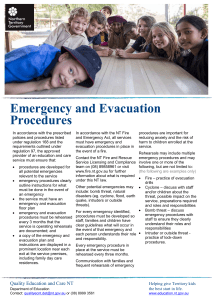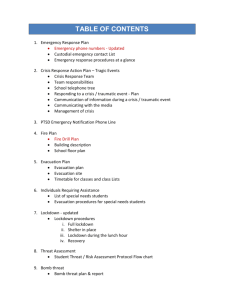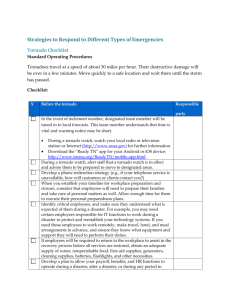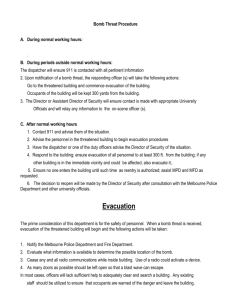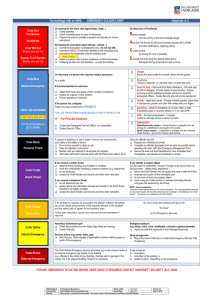Emergency Actions Plan - Moultrie Technical College
advertisement
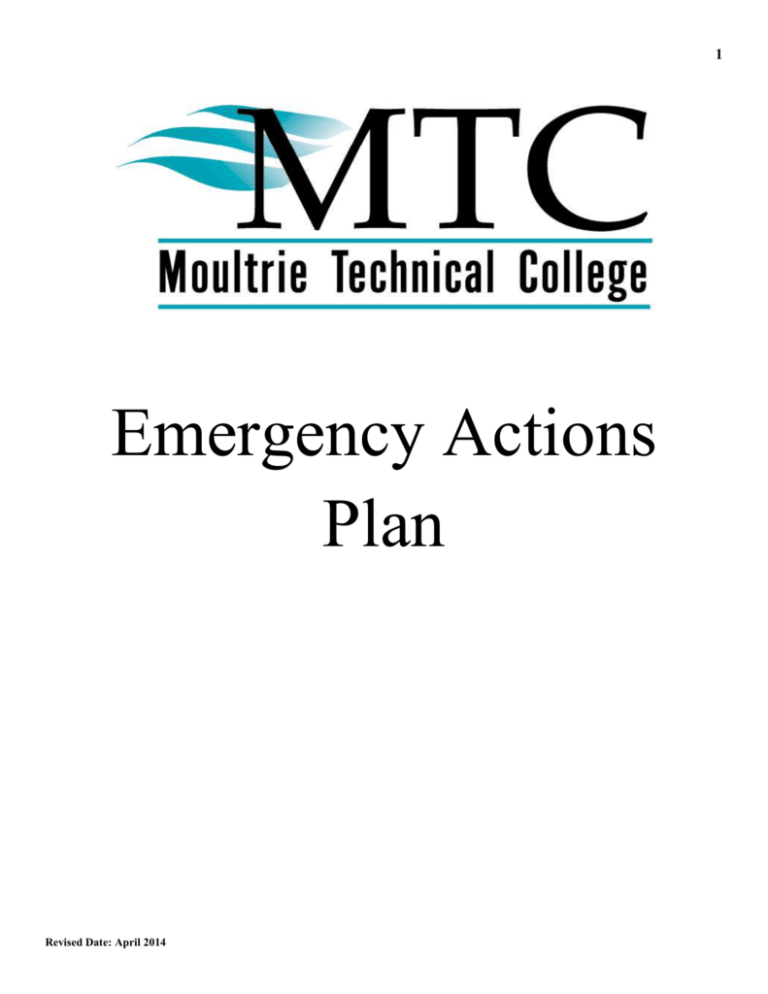
1 Emergency Actions Plan Revised Date: April 2014 2 EMERGENCY PROCEDURES Moultrie Technical College Emergency Procedures: Introduction ............................................................................................ 3 Emergency Telephone Numbers............................................................. 4 First Aid Providers ................................................................................. 5 MTC Emergency Alert System .............................................................. 6 General Procedures................................................................................. 6 Evacuation Guidelines ............................................................................ 7 Evacuating Persons with Disabilities .............................................. 8 Emergency Signals ................................................................................. 9 Accident, Serious Injury, or Illness ........................................................ 11 Exposure Control .................................................................................... 12 Fire ......................................................................................................... 13 Inclement Weather ................................................................................. 15 Tornado Watch or Warning .................................................................... 16 Intruder/Hostage/Terrorism .................................................................... 17 Student Disruptions/Civil Disturbances.................................................. 18 Mental Health Emergency; Menacing Behavior ............................. 19 Violent Crime in Progress .............................................................. 20 Hazardous Materials/Radiological Incident ............................................ 21 Bomb or Bomb Threat ............................................................................ 22 MTC Bomb Threat Data Form ............................................................... 23 Revised Date: April 2014 3 INTRODUCTION The College must provide a safe and orderly environment for its faculty, staff, and students. Even in the face of emergency, the need to maintain this environment is essential. Although it is not possible to think of every type of college disturbance that could threaten the safety of faculty, staff, and students; this plan has been developed to assist college personnel in resolving major emergencies. It is anticipated that adhering to the steps developed in this plan, in the event of an emergency, will maximize the opportunity for the safe protection and, if necessary, orderly evacuation or relocation of all occupants. Safety of building occupants is the primary concern of any emergency plan. The preservation of the building and contents is secondary. Supervisory personnel are directly responsible for the instruction of all employees under their jurisdiction in regard to proper procedures and safe methods to be utilized in performing duties in the working and instructional environment and for taking immediate measures to respond to an emergency. Immediate response to safeguard life and property is made at the administrator, supervisor and employee level most readily available and equipped to respond to the situation. An Emergency Preparedness/Safety Committee is established and serves as an advisory, planning and improvement committee to guide the MTC emergency and safety programs and other tasks necessary to ensure a safe work and learning environment. The committee meets regularly to discuss issues related to safety and security, accident and crime prevention, regulatory issues, and feedback regarding employee and student safety concerns. The committee is also charged with the maintenance of the Plan. Fire and Tornado drills will be held once every semester. Lockdown, Hurricane, and Earthquake drills will be held once annually. Any questions, concern, or suggestions should be directed to a committee member. Members are as follows: Debbie Craft—Chair Daniel Folsom John McFarland Roxanne Stone Todd Presley—Vice Chair Nancy Hall Ernest Kennedy Darrell Wilkerson Janice Baldree Cornelius Ball Joey Fowler Joyce Langdale Mitchell Meadows Steve Peacock Michaela Underwood Although not specifically identified in the above committee; the individual instructor, program director and program chair occupy important roles in the safety program and the management of emergency situations that occur on college property. It is these individuals who have the professional knowledge of the safety issues, rules, and procedures that apply their areas of responsibility. These individuals have the immediate responsibility to ensure that emergency and safety procedures are disseminated and followed in their work and classroom environments. Revised Date: April 2014 4 EMERGENCY TELEPHONE NUMBERS Police/Sheriff Ambulance Fire 911 911 911 Stay on the line—DO NOT HANG UP UNTIL TOLD TO DO SO. Give complete information for responding emergency personnel. Notify Administration: CONTACT NUMBERS OFFICE CELL HOME Acting President (Jim Glass) VP Student Services (Leigh Wallace) VP Economic Development/Satellite Operations (David Evans) VP Administration (Ken Strickland) 217-4137 217-4143 391-2609 217-4188 821-1157 921-8300 821-6090 821-1156 883-2299 Assistant VP, Academic Affairs (Tina Strickland) Dean for Academic Affairs—Moultrie (Kathryn Kent) Dean for Academic Affairs—Tifton (Becky Richardson) Director, Marketing/Public Relations (Jana Wiggins) Director, Facilities (Steve Peacock) Maintenance Supervisor—Veterans Parkway (Todd Presley) Maintenance Supervisor—Industrial Drive (Steve Fletcher) Maintenance Supervisor—Tifton (Scotty Funderburk) Security—Veterans Parkway (Mitchell Meadows) Security—Industrial Drive (Ernest Kennedy) Security—Tifton (Cedric Carruthers) 217-4141 217-4206 391-2624 217-4139 217-4234 217-4158 217-4170 391-2604 777-1005 821-0003 President’s Executive Assistant (Vickie Sangster) VPC Main Desk (Carol Kilgore) Tifton Campus Main Desk (Paula Moser) 217-4137 891-7000 391-2600 Revised Date: April 2014 589-0338 821-0297 821-0445 821-0288 821-0669 821-0042 821-1166 850-0850 821-1155 850-0839 217-4904 507-5418 5 FIRST AID PROVIDERS VETERANS PARKWAY CAMPUS Nancy Plymel Campagna ................................................................................................................................. 217-4177 Andy Clark ....................................................................................................................................................... 217-4173 Debra Craft....................................................................................................................................................... 217-4209 Amber Goodman .............................................................................................................................................. 217-4077 Lisa Griffin....................................................................................................................................................... 217-4144 Laura Hall ........................................................................................................................................................ 217-4254 Dr. Jorge Houed ............................................................................................................................................... 217-4236 Alfred Jones ..................................................................................................................................................... 217-4178 Robin Kern ....................................................................................................................................................... 217-4175 Linda Lofton .................................................................................................................................................... 217-4198 Mitchell Meadows ........................................................................................................................................... 821-0042 Steve Peacock .................................................................................................................................................. 821-0297 Todd Presley .................................................................................................................................................... 821-0445 Pierre Rogers.................................................................................................................................................... 217-4224 Vickie Sangster ................................................................................................................................................ 217-4137 Buffie Spencer ................................................................................................................................................. 891-7030 Paul Tompkins ................................................................................................................................................. 217-4168 INDUSTRIAL DRIVE CAMPUS Steve Fletcher................................................................................................................................................... 821-0288 Jan Fowler ........................................................................................................................................................ 217-4181 Lisa Griffin....................................................................................................................................................... 217-4144 Doug Hall ......................................................................................................................................................... 217-4182 Ernest Kennedy ................................................................................................................................................ 821-1166 Amanda Meads ................................................................................................................................................ 891-7290 Tim Morton ...................................................................................................................................................... 217-4169 Steve Peacock .................................................................................................................................................. 821-0297 Ken Robison..................................................................................................................................................... 217-4153 Megan Sloan .................................................................................................................................................... 217-4184 Brittany Touchton ............................................................................................................................................ 890-6049 TIFTON CAMPUS Angela Bullard ................................................................................................................................................. 391-2637 Kelly Daniell .................................................................................................................................................... 391-2635 Sandy Fletcher ................................................................................................................................................. 391-2653 Joey Fowler ...................................................................................................................................................... 391-2660 Nancy Hall ....................................................................................................................................................... 391-2652 Linda Huggins .................................................................................................................................................. 391-6955 Sherry King ...................................................................................................................................................... 391-2638 Sonja McDonald .............................................................................................................................................. 391-2659 Amy Stewart .................................................................................................................................................... 391-2652 MTC EMERGENCY ALERT SYSTEM Revised Date: April 2014 6 USE: To alert students to school closings for the following circumstances Bad weather Threat of violence on Campus o Bomb Threat o Intruder on Campus o Chemical Spill Alerts will be made via telephone call, text message, email, and posted on Facebook. GENERAL PROCEDURES INSTRUCTOR COMMUNICATION WITH THE PRESIDENT’S OFFICE/SECURITY/STUDENT SERVICES: At times, an emergency will occur in the classroom or in the hallway near a classroom. The instructor will need to communicate to Security, the President’s office and the Student Services office that an emergency situation has occurred. Here are a few suggestions on reporting: 1. Send a student messenger to Security/Student Services by a safe route. 2. Call the Security/Student Services by telephone if possible. 3. Ask another instructor or staff member for assistance in getting the message to Security/Student Services. COMMUNICATION WITH STUDENT BODY DURING CRISIS SITUATIONS: 1. Use megaphone (located with Emergency Preparedness Kit), PA System and MTC Alert when giving directions for entire student body. 2. Use cell phone/office phone, if available, to communicate with administrative personnel and campus supervisors. DO NOT USE CELL PHONES OR OTHER ELECTRONIC DEVICES IN THE CASE OF A BOMB THREAT. Send a messenger. ASSOCIATING WITH THE PRESS: All matters pertaining to the media should be immediately referred to the President or PR/Marketing Specialist. 1. Greet the reporter/television crew politely. Tell them to wait in the designated area. 2. Call the President’s office and advise the president the whereabouts of the media personnel. 3. No students should be interviewed and/or photographed during a crisis, controversial, commercial, or political situation. Revised Date: April 2014 7 EVACUATION GUIDELINES Evacuation of Campus Building(s) required because of: Fire Bomb Threat Fire: Evacuate building(s) 300 feet. Proceed to nearest Assembly Area. FIRE ASSEMBLY AREAS Industrial Drive Campus Buildings 100, 200, 400, 500, 600—South Parking Lot Buildings 300, 700, 800—North Parking Lot Building 900—East Parking Lot Veterans Parkway Campus Building A—Building A Parking Lot Building B—Building B Parking Lot Building C—Building A Parking Lot Tifton Campus Buildings A, B—North East Parking Lot Building C—South Parking Lot Building D, Fire Science, Economic Development—Southwest Parking Lot Building F, Mobile Units—West Grassed Area Truck Driving—Truck Driving Course Ashburn Campus—City Resource Center Farthest area of parking lot Sylvester Adult Education Center South Parking Lot or Football Practice Field Behind Building Farm Front of Building Grassed Area Bomb Threat: Evacuate building(s) 1,000 Feet. Proceed to nearest Assembly Area designated by Administration. CAUTION: Evacuees should be careful crossing roadways. Be alert to responding Emergency vehicles. Bomb Threat: Stay clear of vehicles in the parking lot. Revised Date: April 2014 8 EVACUATING PERSONS WITH DISABILITIES Instructors and staff should be proactive and be aware of people who will need assistance. Instructors should notify the Disabilities Services Coordinator each semester of all persons with disabilities who may need assistance during an emergency. Assisting Blind/Visually Impaired: Clearly announce the type of emergency Offer your arm for guidance Tell the person where you are going, and alert him/her to obstacles along the way Assisting Deaf/Hearing Impaired: Turn lights on and off to gain the person attention Indicate directions with gestures or a written note Assisting Mobility-Impaired/Wheelchair users: Elevators should not be used to move people with disabilities Seek volunteers to assist students/personnel with physical disabilities to the nearest enclosed stairway or designated areas for rescue assistance One individual should remain with the person(s) if it can be done without unreasonable personal risk Others should advise emergency personnel of the location so that the evacuation can be completed If an imminent danger situation exists and the person requests assistance in evacuation before emergency personnel can arrive, assist in finding volunteers to evacuate the person per his/her instructions Revised Date: April 2014 9 EMERGENCY SIGNALS The following emergency signals will be used to direct emergency actions of employees and students. EMERGENCY EVACUATION Fire/Bomb Threat/Chemical Spill: Sounding of fire alarm PA System Messenger—during power outages and Bomb threats Flashing fire alarm strobe lights MTC Emergency Alert System (Do NOT use during Bomb threat) Instructions: Depart the building via nearest exit Use stairs: DO NOT USE ELEVATORS Evacuate to designated assembly area Stay clear of roadways and responding emergency vehicles Stay clear of all parking lots and vehicles TAKE COVER Tornado Warning: PA System MTC Emergency Alert System Messenger (during power outage) Instructions: PROCEED TO THE HALLWAY (OR WINDOWLESS ROOM) ON THE GROUND FLOOR Use stairs: DO NOT USE ELEVATORS. (HANDICAP USE ONLY) Stay clear of windows and skylights Close fire doors LOCK DOWN Intruder/Hostage/Terrorism: PA System Messenger (during power outage) MTC Emergency Alert System Revised Date: April 2014 10 Instructions: Lock all doors. Turn off all lights Move away from all doors and windows. Take cover ALL CLEAR PA System MTC Emergency Alert System Messenger (during power outage) Instructions: Return to classroom/work area Revised Date: April 2014 11 ACCIDENT, SERIOUS INJURY, OR ILLNESS DEFINITION: Emergency where one may be sick or injured; immediate concern is to aid the sick or injured person SIGNALS: None ACTIONS: 1. Contact First Aid Providers for assistance. See page five (5) for your campus First Aid Providers. 2. Contact emergency services: 911 3. Contact Student Services/appropriate administrator and stay with the sick/injured person 4. Disperse the crowd, if necessary 5. Utilize first aid/follow universal precautions. Do not move the victim unless in danger of further injury 6. Inform staff/students as needed 7. Complete accident report form and file in Business Office ROLES: First Aid Providers Administer First Aid as needed Contact 911 and Student Services VP Student Services Supervise care of person(s) Communicate with parents/family Secretary Aid in communication with emergency services Contact President’s office, if appropriate Nursing Instructors Aid instructors and others in first aid Instructors Stay with students, assess first aid needs, and contact Student Services, if appropriate Staff Help with communication to family, if necessary Assist with first aid Security Maintain crowd control Direct Emergency Personnel to injured/sick person Revised Date: April 2014 12 EXPOSURE CONTROL UNIVERSAL PRECAUTIONS: Most approaches to infection control are based on a concept called Universal Precautions. It requires that persons administering aid consider every person, all blood and body fluids to be a potential carrier of infectious disease. When administering first aid, the standards of practice listed below should be followed. ACTIONS: 1. Wash hands with antiseptic wipes if there is any possibility of contact with blood, body fluids or human tissue from an injured worker. Wash hands with soap and water as soon as possible 2. Wear gloves when anticipating contact with blood, body fluids, tissues, mucous membranes or contaminated surfaces, or if breaks in the skin are present 3. Wear an impervious gown or apron if splattering of clothing is likely 4. Wear a mask if there is to be contact with an infectious disease spread by splatter droplets 5. Wear appropriate protective equipment at all times including a mask and eye protection if splattering is likely to occur when attending to an injured person 6. Make mouthpieces, resuscitation bags and other resuscitation devices readily available for use in areas where the need for resuscitation is likely and carry appropriate devices in emergency response kits 7. Handle sharp objects carefully Do not cut, bend, break or reinsert used needles into original sheath by hand Discard sharp objects intact, immediately after use into an impervious sharps disposal box which should be carried whenever needles are in the emergency response kit Report immediately all needle stick accidents, mucosal splashes or contamination of open wounds with blood or body fluids 8. Dispose of all spills which contain or may contain biological contaminants in accordance with policies for hazardous waste disposal. Until cleanup is complete, the accident area should be roped off to other workers Revised Date: April 2014 13 FIRE DEFINITION: A fire in the building or on the premises requiring the evacuation of the building(s) SIGNALS: Fire Alarm; Flashing Strobe Lights PA System MTC Emergency Alert System Messenger (during power outage) Try to stay calm and remember: R.A.C.E.—Rescue, Alarm, Confine, Evacuate or Extinguish ACTIONS: 1. Activate fire alarm by pulling nearest pull-station 2. Notify Fire Department and Police by dialing 911 Give your name and location Give the location of fire 3. Fight the fire with a fire extinguisher ONLY if: The fire department has been notified, AND The fire is small and confined to its area of origin, AND You have a way out and can fight the fire with your back to the exit, AND You have the proper extinguisher, in good working order, AND You know how to use it If you are not sure of your ability or the capability of the fire extinguisher to contain the fire, GET OUT AND LEAVE THE FIRE FIGHTING TO THE EXPERTS 4. Close all doors and windows to confine the fire 5. Instructions and information will be broadcast using the MTC Emergency Alert System. 6. Evacuate the building (Assist Handicapped) and proceed to designated assembly area 7. Instructors stay with student and confirm roll 8. Remain in assembly area until you receive the “ALL CLEAR” from the Fire Department IF TRAPPED: 1. Secure your area from smoke. Close doors. If possible, use wet towels, clothing, etc. to seal large gaps under doors. 2. Yell or hang an object (towel, shirt, coat, etc.) out the window to attract attention. Use the telephone to call Security (VPC: 229-821-0042, IDC: 229-821-1166, Tifton: 229-850-0850) or anyone to advise them of your situation and your location. 3. ONLY AS A LAST RESORT: If you are trapped and unable to communicate and no one is likely to know you are there, should you consider using a fire extinguisher, fire blanket, coat, etc. in an attempt to escape through a fire. Remain low to the floor to avoid smoke and crawl to your nearest exit Revised Date: April 2014 14 ROLES: President Supervise evacuation and check for injuries Assign roles to auxiliary persons as needed Keep access roads open First Aid Providers Administer first aid/see Universal Precautions (see page ) Instructors Evacuate Take roll Floor Marshalls (Custodians) Check restrooms and other areas for students and faculty Make sure evacuation is complete Check with president when area is clear Security Maintain crowd control Direct emergency personnel Revised Date: April 2014 15 INCLEMENT WEATHER DEFINITION: Snow, ice or extremely cold weather; floods, hurricanes; etc SIGNALS: PA System Messenger (during power outage) MTC Emergency Alert System ACTIONS: During the school day: 1. NOAA Weather radio will alert to weather situation 2. Evaluate actions to be taken 3. Students will remain in rooms until advised about school operation 4. President decides to suspend class—will advise faculty and students 5. Personnel will depart the campus 6. Instructions and information will be broadcast using MTC Emergency Alert System Before the school day or school not in session: 1. If the weather forecast is for some type of severe weather and the president decides to suspend classes and/or school operations, the decision will be broadcast over the following media resources: FM radio WMTM 93.9 Moultrie FM radio 95.3 TV Channel 10 WALB School closing will also be broadcast using the MTC Emergency Alert System ROLES: President Notify staff as needed Utilize Emergency Telephone Notification, if needed Call emergency numbers, if necessary Maintenance Check on buildings as weather permits Come in early on the first day back and check steps, stairs, and sidewalks Place caution signs as needed PR/Marketing Inform Media Security Provide assistance as needed Revised Date: April 2014 16 TORNADO WATCH OR WARNING DEFINITION: Tornado Watch: Conditions are favorable for a tornado or severe weather. Make staff aware, but take no action Tornado Warning: Tornado has been sighted; take shelter immediately SIGNALS: (See EMERGENCY SIGNALS page 7) PA System Messenger (during power outage) o *TAKE COVER* o *ALL CLEAR* MTC Emergency Alert System ACTIONS: 1. Agency receives the Tornado Warning via NOAA emergency radio 2. Notify President’s Office/evening manager immediately 3. President/evening manager to issue take cover signal *TAKE COVER* signal is initiated Instructions and information will be broadcast using the MTC Emergency Alert System 4. Instructors, staff, and students PROCEED TO HALLWAY OR WINDOWLESS ROOMS ON GROUND FLOOR. DO NOT USE ELEVATORS. (HANDICAP USE ONLY) Stay clear of windows and skylights Close fire doors 5. Students should not be permitted to leave the school during a TORNADO WARNING 6. Instructors are to close windows and doors upon leaving with their students 7. Instructors should keep their class rosters and verify student classroom count 8. When the all clear signal is initiated, return to classroom/work area Note: Each room has an evacuation sheet that gives the locations of where to assemble for a tornado. Be familiar with this sheet. ROLES: President Maintain contact with student body and staff Initiate alarm as necessary Use megaphone for crowd control if necessary Give the All Clear signal Student Services Man phones and monitor weather radios Security Provide assistance as needed Note: Tornado watches may last from two to six hours. Revised Date: April 2014 17 INDIVIDUAL POSING THREAT REQUIRING SHELTER IN PLACE DEFINITION: Any person(s) on the school premises who may present a threat to students, guests, faculty and staff SIGNALS: 1. PA System 2. Messenger (during power outage) 3. MTC Emergency Alert System If the individual is in the hall, staff will call security. (VPC: 821-0042; IDC: 821-1166; Tifton: 850-0850; Ashburn—City Resource Center: 911; Sylvester: 911) Security will assess the situation and determine if the individual should be escorted off of property or if individual needs to talk to a member of the staff. If the individual presents a threat or is armed, notify 911, security, and the President’s Office or Student Affairs immediately so that shelter in place can be announced over the PA. ACTIONS: 1. Staff who spots armed individual will call 911 and report the situation to Security. Also call the President’s Office or Student Affairs. 2. Security will assess the situation and direct action. 3. Any staff or faculty member may give the shelter in place alert by calling the President’s Office or Student Affairs. Ask whoever is in the President’s Office or Student Affairs to make the shelter in place announcement. 4. Lock all doors. Turn off all lights. Silence cell phones and remain as quiet as possible. 5. Move away from all doors and windows. Take cover. If you are able to get to a safe place with no windows and only an interior door that locks, move to that location. 6. If you cannot get to a safe place, try to get away from the individual. 7. If no escape is possible, be prepared to fight individual, looking for anything that will help you defend yourself if possible. 8. Follow Police instructions. 9. Instructions and information will be broadcast using the MTC Emergency Alert System. ROLES: President or Senior Administration Take charge of the situation and call police, if needed Give the All Clear signal Security Provide assistance as needed to law enforcement Follow directives given by President or Senior Administration Instructors Lock doors and await further instructions Take roll Instruct students, as needed, to follow procedures Revised Date: April 2014 18 STUDENT DISRUPTIONS/CIVIL DISTURBANCES DEFINITION: An incident that disrupts or has the potential to disrupt the orderly functions of the school Level 1: Disruption is confined to one area, but no threat to students or staff Level 2: Disruptive forces are mobile or pose a direct threat to students and/or staff Level 3: Disruptive is widespread with large-scale student to participation and is a serious threat to students and staff SIGNALS: 1. Use PA system to signal level and location of disruption (e.g., “level 3-Bldg. B-second floor”). Specific instructions should follow. 2. If staff is reporting disruption to Student Services, send messenger to office by safe route. Indicate description and location of disruption. ACTIONS: 1. Isolate disruption. Keep students in classrooms. Initiate building lock-down, if necessary, by locking classroom doors, offices and entrances. In case of lock-down, instructions and information will be broadcast using the MTC Emergency Alert System 2. Clear the immediate area, including restrooms and hallways. Use megaphone for crowd control 3. Use intercom to signal level, location and specific instructions 4. If disruption is Level 2 or 3, call 911 5. If disruption is Level 2 or 3, staff members trained in CPR and first aid (if they are not supervising students) should go to the area 6. Instructors should not leave students unsupervised 7. Use intercom to signal that disruption is over ROLES: President Assess level of disruption Supervise response to disruption Give intercom signals. Give directions using megaphone if necessary Secretary Contact Emergency Services Instructors Stay with students Security Keep visitors and outsiders from entering the building FOLLOW-UP: 1. Activate Senior Staff if necessary 2. Hold staff meeting to discuss disruption 3. Prepare Press Release (if necessary) Revised Date: April 2014 19 MENTAL HEALTH EMERGENCY In the event of overtly threatening behavior constituting an immediate threat to self or others, notify Campus Security and Student Affairs. In non-emergency situations, refer students to Student Affairs. ACTIONS: 1. Express your concerns directly to the individual 2. Make referral in presence of the individual and offer to accompany them 3. Watch for changes in behavior: Significant changes in academic or work performance Changes in hygiene, speech, attentiveness or social interaction Sever loss of emotional control High levels of irritability Impaired speech or garbled/disjointed thoughts Excessively morbid, violent or depressing themes in written assignments Verbal expression of suicidal or violent thoughts MENACING BEHAVIOR Stay calm and unhurried in your response to the person Be empathetic and show your concern Try to set down with the person, as sitting is less aggressive posture than standing or moving around Be helpful. Schedule an appointment for a later time and take notes Provide positive feedback such as “we can get this straightened out”, or “I’m glad you’re telling me how you feel about this” Stay out of arms reach Limit eye contact Do not argue, yell or joke Do not touch the person If the individuals level of agitation increases, attempt the following: Leave the scene Notify Security and Student Affairs Alert co-workers using an agreed-upon code word to indicate trouble Do not allow menacing behavior to go unreported. Alert Security, Student Affairs and coworkers immediately after the person leaves Revised Date: April 2014 20 VIOLENT CRIME IN PROGRESS If exiting the building is possible: Exit the building immediately Notify others as you are exiting the building Be aware of your surroundings Notify Security and Student Affairs upon reaching a safe location If exiting the building is not possible: Go to the nearest room or office Close and lock the door Cover the door windows Keep quiet and act as if no one is in the room DO NOT answer the door Notify Security and Student Affairs Revised Date: April 2014 21 HAZARDOUS MATERIALS/RADIOLOGICAL INCIDENT DEFINITION: Incident involving hazardous materials that pose a threat to faculty, staff, and students and possibly the local community SIGNALS: 1. MTC Emergency Alert System 2. PA System if necessary 3. Messenger during power outage 4. Inform staff/students: What is going on and why? OR Send a note (e-mail) to all staff explaining the emergency, give specific instructions ACTIONS: 1. Restrict access to area of hazardous materials (spill) 2. One (1) gallon or less: Refer to the chemicals Material Safety Data Sheet (MSDS) for spill clean-up MSDS Section Seven (7), “Precautions for Safe Handling and Use” Use recommended Personal Protective Equipment (PPE) Use appropriate neutralizer and absorbent medium Most solids can be swept up Transfer material into appropriate container Contact Maintenance Department for proper disposal 3. Over one (1) gallon: Cordon area off within 250 ft. of spill Evacuate personnel upwind Utilize Hazardous Spill Kit Notify Fire Department/Police 911 Obtain MSDS sheet and provide to responders 4. Instructions and information will be broadcast using the MTC Emergency Alert System ROLES: President Oversee response activities Secretary Coordinate communication Instructors Maintain normal routine unless otherwise instructed Security Assist in traffic control/crowd control into and out of school site Revised Date: April 2014 22 BOMB OR BOMB THREAT DEFINITION: A device present in the school or on the premises which may or may not have exploded SIGNAL: 1. Messengers ACTIONS: 1. Notify President or designated representative, Call 911 on a land-line; work cooperatively with Law Enforcement Agency responding to call 2. Obtain as many details as possible if a bomb threat is made. Record identifying information (see next page) 3. Evacuate the building and move to designated assembly area 4. Have staff look for unusual or suspicious noises, devices or disturbances while evacuating the building. Report suspicious items to the bomb squad 5. Protect face and head with arms, books, coats, etc. from flying debris 6. Leave door open; do not use switches, cell phones, or other electronic devices 7. Instructions and information will be broadcast using the MTC Emergency Alert System ROLES: President Determine the need for evacuation and notify staff Gather information from staff on anything suspicious Assess injuries Assign qualified staff to first aid assistance at designated assembly area Secretary Call emergency numbers listed Take emergency information folder to evacuation site Maintenance Report to President Secure building by shutting off gas and electricity Instructors Evacuate to designated area; remain with class; take roll Security Provide assistance as needed Revised Date: April 2014 23 MTC BOMB THREAT DATA FORM This checklist should be duplicated and placed at phone station that receives direct incoming calls from any source. All who staff those lines must be trained in the use of this checklist. STEP 1: RECORD THE THREAT. If you have recording equipment, START IT. Telephone number at which call was received: __________________________ Extension: _______________ Date Call Received: ___________________________________ Time Call Received: ____________________ Write down the threat exactly as made by the caller: ______________________________________________ __________________________________________________________________________________________ __________________________________________________________________________________________ _________________________________________________________________________________________ Phone number Appearing on Caller ID, if available: ______________________________________________ STEP 2: GET MORE INFORMATION Ask the following questions (The caller may provide more information than you may expect in order to draw attention to his/her cause.) “Where is the bomb right now?” (If the caller refuses to answer, say “The building is occupied and that the detonation could result in death or serious injury to many innocent children.”) __________________________________________________________________________________________ “When was the bomb planted?” _______________________________________________________________ “When is the bomb going to explode?” _________________________________________________________ “What does the bomb look like?” ______________________________________________________________ “What will cause the bomb to explode?” ________________________________________________________ “Who planted the bomb?” ___________________________________________________________________ “Why was the bomb planted?” ________________________________________________________________ “What is your address?” _____________________________________________________________________ “What is your name?” ______________________________________________________________________ “How did the person get the bomb in the building?” ______________________________________________ STEP 3: DESCRIBE THE ATMOSPHERE Background Sounds Heard on the Call (Circle ALL that apply): Street Noises Children Construction Music Animal Noises Echo Airplanes (propeller/jet) Machinery Motor House Noises Quiet Office Equipment Heavy Equipment PA System Restaurant Noises Party Trains Factory Vehicle Noises Static Bar/Club Noises Other: ____________ Could you make out anything said in the background? What did you hear? ___________________________ __________________________________________________________________________________________ __________________________________________________________________________________________ Revised Date: April 2014 24 STEP 4: DESCRIBE THE CALLER Sex of the caller: (Mark one) __________Male __________Female __________Unsure Approximate age of the caller: __________ Caller’s Voice was… (Circle ALL that apply.) SPEED AND PITCH EMOTION QUALITY LANGUAGE Hurried or Rapid Distant Stutter Accented (___________) Moderately paced Excited Lisp Well-spoken Slow Angry Slurred Foul Hushed or Quiet Sad Whispered Taped Loud Happy Laughing or Giggling Incoherent Deep Calm Raspy Message read High-pitched Agitated Nasal Irrational Squeaky Matter-of-Fact Deep Breathing Broken Other: ______________ Boastful Crying Drunk Sincere Stressed Other: ______________ Crazed Whining Other: ______________ Clearing Throat Cracking Voice Other: ______________ STEP 5: PERSON WHO RECEIVED THE CALL Your Name: _____________________________________ Title: ____________________________________ Your Telephone Number: _______________________ Was a recording of the call made: _____Yes _____ No Department Name: _______________________________ Location: _________________________________ Any other remarks about the call: _____________________________________________________________ __________________________________________________________________________________________ __________________________________________________________________________________________ NOTIFY THE POLICE AND/OR SECURITY IMMEDIATELY AND THEN YOUR SUPERVISOR. POLICE DEPARTMENT ....................................................................................................................... DIAL 911 CAMPUS SECURITY Moultrie...................................................................................................................... VPC Security 229-821-0042 ..................................................................................................................................... IDC Security 229-821-1166 ............................................................................................................................................... No answer DIAL 911 Tifton................................................................................................................................................. 229-850-0850 Ashburn City Resource Center ............................................................................................................... DIAL 911 Sylvester Adult Ed .................................................................................................................................. DIAL 911 Revised Date: April 2014
